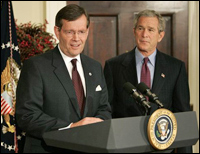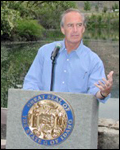
Leavitt, left, accepts Bush’s nomination to head HHS and leave EPA behind.
Photo: WhiteHouse.gov.
There were plenty of “Leavitt or leave it” jokes when former Utah Gov. Mike Leavitt (R) took the helm at the U.S. EPA just over a year ago. Many insiders didn’t expect him to stay long at the agency, figuring he would get promoted after doing the dirty work on the heels of Christie Whitman‘s prickly departure from the post.
But few expected Leavitt to leave it quite so soon.
His nomination on Monday to head up the Health and Human Services Department landed as quite a surprise, particularly coming just two days after Leavitt publicly announced that he and President Bush would make air pollution a top priority in Congress early next year, starting with “a strong push” to build support for Bush’s Clear Skies initiative. And a few weeks previous, Leavitt told the Los Angeles Times that he had big plans to remake the EPA as a number of career agency employees head toward retirement.
Speculation has now turned toward Leavitt’s successor. Folks are wondering whether the new head of EPA will have more expertise in the environmental arena than Bush’s recent nominee for energy secretary has in his new dominion.

Sam Bodman.
Sam Bodman, while highly credentialed in other fields — he’s had stints as an MIT professor of chemical engineering, a business exec, and a senior official under Bush at both the Commerce and Treasury departments — doesn’t appear to know diddly about energy. He was picked for his dependability. “Bodman proved himself a loyal and trusted ally with the president,” energy lobbyist Frank Maisano told Muckraker. “That was a top priority for the position.”

Jim Connaughton.
If loyalty is a top priority for the EPA spot as well, there are two first-term Bush administration officials abundantly qualified for the job: Jim Connaughton, current chair of the White House Council on Environmental Quality, is perhaps the most public advocate of the Bush administration’s “new environmentalism.” And Lynn Scarlett, assistant interior secretary in charge of the department’s Office of Policy, Management, and Budget, is one of the most influential behind-the-scenes architects of Bush’s environmental agenda. Her unflappable persona could serve her well in the EPA chief position, widely considered one of the more grueling and thankless posts in the Beltway.
Unlike Leavitt and Whitman, both Connaughton and Scarlett have significant experience on environmental matters and appear to care deeply about the issues (if not in the way the environmental community might like them to).
“Being EPA chief is a miserable position if you don’t fundamentally care about it,” said Eric Schaeffer, formerly a top enforcement official at the EPA who resigned in protest of Bush’s policies. “You have to be a fighter, and what’s more demoralizing than having to fight for something you don’t give a damn about?”
Other, lesser-known potential candidates with environmental backgrounds include Tom Skinner, EPA’s acting enforcement chief; David Struhs, former head of the Florida Department of Environmental Protection and now a top official at International Paper Co.; and Doug Benevento of the Colorado Department of Public Health and Environment.
But, ironically, Connaughton, Scarlett, and others in their mold might care too much. “The Bush administration will shy away from anyone who really believes in these issues on their side,” said Schaeffer, “because that belief tends to be ideologically inflected. It’s belief informed by years of industry experience, or it’s ideology pitted against so-called ‘command and control’ regulations. That won’t go over well in the [Senate] confirmation.”
Instead, chances seem good that Bush will pick a politician with relatively shallow experience in environmental protection, like Leavitt, not a policy wonk. “If they have big plans to push controversial legislation like Clear Skies,” said Schaeffer, “they’ll want someone who can jump into the battle zone with a clean record and no mud on their face.”

Dirk Kempthorne.
The most obvious possibility in this case is Idaho Gov. Dirk Kempthorne (R), who was courted by the Bush administration for the EPA slot the last time it was open, in 2003. Bill Owens, Republican governor of Colorado, is also a possibility; he’s rumored to want to move up to the federal level, but his record contains some environmental controversies that might make him a less attractive candidate. Former Michigan Gov. John Engler (R) is also said to be on the list of potentials, though his recent appointment to head up the National Association of Manufacturers might make folks wonder how enthusiastic he’d be about enforcing EPA regulations.
More controversial still would be the darkest horses running through the rumor mill, both of whom have headed up powerful industry trade groups not known for their love of environmental-protection initiatives: Josephine Cooper, former president of the Alliance of Automobile Manufacturers, and Tom Kuhn, current president of the Edison Electric Institute.
No matter who gets the nod, Bush’s environmental agenda is unlikely to change much. As Leavitt explained last month, the administration is interpreting its electoral victory as a clear mandate to forge ahead with its environmental policy priorities, and any new EPA chief will surely be sipping from the same Kool-Aid.

